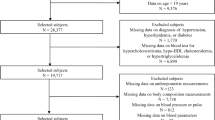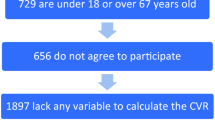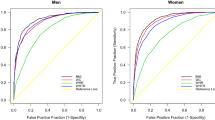Abstract
OBJECTIVE: To assess the ability of the body mass index (BMI) to detect obesity-associated morbidity in subjects with a normal or short stature.
METHODS: Information was obtained on 119?975 subjects from a cardiovascular risk factors detection program. Standardized questionnaires were used. Capillary glucose and cholesterol concentrations were measured. Diabetes, arterial hypertension and hypercholesterolemia were selected as end points. Sensitivity, specificity and the likelihood ratio for several BMI thresholds were calculated. ROC curves were constructed to identify the BMI cutoff points with best diagnostic performance. The area under the curve (AUC) was used to assess the proficiency of BMI.
RESULTS: Short stature (height ≤150?cm for women or ≤160?cm for men) was found in 24?854 subjects (20.7%). These cases had a higher prevalence of type II diabetes and arterial hypertension even after adjusting for confounding variables. In addition, the frequency of the abnormalities was higher even at the lowest BMI values; the prevalence increased in direct proportion with the BMI, but at a lower rate compared to cases with normal stature. The AUC for every co-morbidity was smaller in short stature subjects. The likelihood ratio for detecting co-morbidities increased at the same BMI value in subjects with or without short stature.
CONCLUSIONS: The prevalence of obesity-associated co-morbidities is higher in subjects with short stature compared to those without it. The proficiency of BMI as a diagnostic tool is poor in short stature subjects. This problem is not resolved by decreasing BMI thresholds used to define overweight.
This is a preview of subscription content, access via your institution
Access options
Subscribe to this journal
Receive 12 print issues and online access
$259.00 per year
only $21.58 per issue
Buy this article
- Purchase on Springer Link
- Instant access to full article PDF
Prices may be subject to local taxes which are calculated during checkout


Similar content being viewed by others
References
Deurenberg P, Yap M, van Staveren WA . Body mass index and percent body fat: a meta analysis among different ethnic groups. Int J Obes Relat Metab Disord 1998; 22: 1164–1171.
Stevens J, Cai J, Juhaeri J, Thun M, Wood J . Evaluation of WHO and NHANES II standards for overweight using mortality rates. J Am Dietet Assoc 2000; 100: 825–827.
Deurenberg-Yap M, Deurenberg P . Is a re-evaluation of WHO body mass index cut-off values needed? The case of Asian in Singapore. Nutr Rev 2003; 61: S80–S87.
Deurenberg P, Deurenberg-Yap M . Differences in body-composition assumptions across ethnic groups: practical consequences. Curr Opin Clin Nutr Metab Care 2001; 4: 377–383.
Ministry of Health: Health statistics. Available on www.ssa.gob.mx. Accessed on September 29,2003.
Rich-Edwards JW, Colditz GA, Stampfer MJ, Willett WC, Gillman MW, Hennekens CH, Speizer FE, Manson JE . Birthweigth and the risk for type 2 diabetes mellitus in adult women. Ann Int Med 1999; 130: 278–284.
Eriksson JG, Forsen TJ, Osmond C, Barker DJ . Pathways of infant and childhood growth that lead to type 2 diabetes. Diabetes Care 2003; 26: 3006–3010.
Barker DJ . The developmental origins of adult diseases. Eur J Epidemiol 2003; 18: 733–736.
Lopez JC, Montesinos R, Velázquez C, González-Barranco J . Short stature is related to high body fat composition despite body mass index in a Mexican population. Arch Med Res 2003; 34: 137–140.
Expert Committee on Diagnosis Classification of Diabetes Mellitus. Report of the Expert Committee on Diagnosis and Classification of Diabetes Mellitus. Diabetes Care 1997; 20: 1183–1197.
Alberti FGMM, Zimmet PZ for the WHO Consultation. Definition, diagnosis and classification of diabetes mellitus and its complications. Part 1:Diagnosis and classification of diabetes mellitus, provisional report of a WHO consultation. Diabet Med 1998; 15: 539–553.
Expert panel on detection, evaluation and treatment of high blood cholesterol in adults. Executive summary of the third report of the National Cholesterol Education Program (NCEP). Expert panel on detection, evaluation and treatment of high cholesterol. JAMA 2001; 285: 2486–2497.
Simel DL, Samsa GP, Matchar DB . Likelihood ratios with confidence: sample size estimation for diagnostic test studies. J Clin Epidemiol 1991; 44: 763–770.
Prentice AM, Jebb SA . Beyond body mass index. Obes Rev 2001; 2: 141–147.
Jousilahti P, Tuomilehto J, Puska P . Relation of adult height to house-specific and total mortality:a prospective follow-up study of 31,199 middle aged men and women in Finland. Am J Epidemiol 2000; 151: 1112–1120.
Forsén T, Eriksson J, Qiao Q, Tervahauta M, Nissinen A, Tuomilehto J . Short stature and coronary heart disease: a 35-year follow-up of the Finnish cohorts of the Seven Countries Study. J Intern Med 2000; 248: 326–332.
Forsen T, Eriksson J, Tuomilehto J, Reunanen A, Osmond C, Barker D . The fetal and childhood growth of persons who develop type 2 diabetes. Ann Intern Med 2000; 133: 176–182.
Williams S, St George IM, Silva PA . Intrauterine growth retardation and blood pressure at age seven and eighteen. J Clin Epidemiol 1992; 45: 1257–1263.
Hales CN, Barker DJP . Type 2 diabetes mellitus: the thrifty phenotype hypothesis. Diabetologia 1992; 35: 595–601.
Jaquet D, Gaboriau A, Czernichow P, Levy-Marchal C . Insulin resistance early in adulthood in subjects born with intrauterine growth retardation. J Clin Endocr Metab 2000; 85: 1401–1406.
Frankel S, Elwood P, Sweeetnam P, Yarnell J, Smith GD . Birthweight, adult risk factors and incident coronary heart disease: the Caerphilly Study. Public Health 1996; 110: 139–143.
Fall CH, Vijayakumar M, Barker DJ, Osmond C, Duggleby S . Weight in infancy and prevalence of coronary heart disease in adult life. BMJ 1995; 310: 17–19.
Gonzalez-Barranco J, Ríos-Torres JM, Castillo-Martinez L, López-Alvarenga JC, Aguilar-Salinas CA, Bouchard C, Desprès JP, Tremblay A . Effect of malnutrition during the first year of life on adult plasma insulin and glucose tolerance. Metabolism 2003; 52: 1005–1011.
Boulé NG, Tremblay A, González-Barranco J, Aguilar Salinas CA, Lopez JC, Despres JP, Bouchard C, Gomez Perez FJ, Castillo L, Rios JM . Insulin resistance and abdominal adiposity in young men with documented malnutrition during the first year of life. Int J Obes Relat Metab Disord 2003; 57: 598–604.
Deurenberg-Yap M, Chew SK, Deurenberg P . Elevated body fat percentage and cardiovascular risks at low body mass index levels among Singaporean Chinese, Malays and Indians. Obes Rev 2002; 3: 209–215.
Stevens J, Nowicki E . Body mass index and mortality in Asian populations; implications for obesity cut-points. Nutr Rev 2003; 61: 104–107.
Acknowledgements
We greatly appreciate the support of Pfizer who covered the expenses of the survey. Also, we appreciate the help of Antonio R Villa for the statistical analysis.
Author information
Authors and Affiliations
Corresponding author
Rights and permissions
About this article
Cite this article
Lara-Esqueda, A., Aguilar-Salinas, C., Velazquez-Monroy, O. et al. The body mass index is a less-sensitive tool for detecting cases with obesity-associated co-morbidities in short stature subjects. Int J Obes 28, 1443–1450 (2004). https://doi.org/10.1038/sj.ijo.0802705
Received:
Revised:
Accepted:
Published:
Issue Date:
DOI: https://doi.org/10.1038/sj.ijo.0802705
Keywords
This article is cited by
-
Waist-to-height ratio is a better discriminator of cardiovascular disease than other anthropometric indicators in Kurdish adults
Scientific Reports (2020)
-
Optimal waist-to-height ratio cutoff values for predicting cardio-metabolic risk in Han and Uygur adults in northwest part of China
European Journal of Clinical Nutrition (2015)
-
Waist-to-height ratio, waist circumference, and body mass index as indices of cardiometabolic risk among 36,642 Taiwanese adults
European Journal of Nutrition (2013)
-
Risk of type 2 diabetes according to traditional and emerging anthropometric indices in Spain, a Mediterranean country with high prevalence of obesity: results from a large-scale prospective cohort study
BMC Endocrine Disorders (2013)
-
Waist‐to‐height Ratio and Coronary Artery Disease in Taiwanese Type 2 Diabetic Patients
Obesity (2008)



